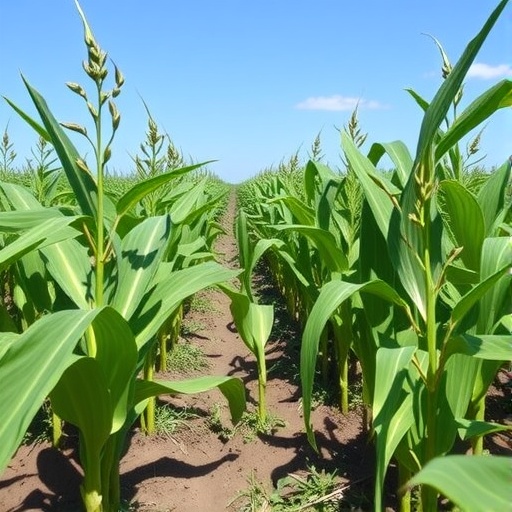In a groundbreaking study, researchers have delved deep into the world of soybean cultivation, specifically targeting the enhancement of biomass partitioning and yield traits. Conducted by Guanzon and Rivera, the research focuses on the interaction between soybean plants, scientifically known as Glycine max, and specific biological and chemical treatments that promise to elevate agricultural productivity. This exploration is timely and essential, given that soybeans play a crucial role in global food security and economic sustainability.
At the forefront of this research is the unique use of Bradyrhizobium, a genus of bacteria known for its symbiotic relationship with legumes, which has been historically acknowledged for enhancing nitrogen availability in the soil. These bacteria are not just mere helpers; they have the potential to transform the way soybeans absorb and utilize nutrients, ultimately pushing the boundaries of growth and yield. The role of nitrogen is particularly vital in this scenario, as it is a key component in the formation of proteins, enzymes, and nucleic acids, essential for plant growth and development.
In parallel with the biological aspect, the study also investigates the impact of molybdenum fertilization on soybean plants. Molybdenum, an essential micronutrient, plays a significant role in various enzymatic processes, including those that facilitate nitrogen metabolism. This dual approach of employing both biological and chemical enhancements can potentially result in a synergistic effect, aiding in greater biomass accumulation and improved yield traits. The researchers aimed to uncover how these dual enhancements could redefine our understanding of soybean nutrition.
One of the most intriguing aspects of the study is its focus on biomass partitioning, which refers to how a plant allocates its resources among various structures such as leaves, stems, and roots. A strategic partitioning favors the development of economically valuable parts, such as the beans themselves, over other structures. By harnessing the natural capabilities of Bradyrhizobium in conjunction with targeted molybdenum application, the researchers propose that soybean plants can optimize this resource allocation, consequently leading to higher yields and more robust plants.
The implications of this research are vast, not only for soybean farmers but also for the agricultural industry at large. With the constant pressures of climate change, declining arable land, and the increasing demand for crops, innovative approaches are crucial. This study paves the way for more sustainable farming practices by suggesting ways to enhance crop productivity without relying heavily on chemical fertilizers, thereby minimizing potential environmental impacts.
Early results from the research indicate promising signs of improved biomass partitioning in soybean plants treated with Bradyrhizobium and molybdenum. Plants exhibited increased leaf area and root mass, which are critical factors influencing overall productivity. The combination of enhanced nutritional uptake and optimized growth characteristics can lead to a significant increase in the yield per hectare, making this approach appealing for wide-scale adoption.
Moreover, as industries face the challenges of meeting rising food demands, the focus on such sustainable practices becomes vital. High-yielding, resilient crop varieties will be essential to ensure food security for future generations. This study provides insights that could help breeders and agronomists refine soybean cultivars through advanced biological and chemical interventions.
The research also opens up further inquiries into other potential nutrient combinations that could work synergistically with Bradyrhizobium and molybdenum. By exploring other micronutrients and their interactions within the plant, the agricultural sector could experience a revolution in how crops are nurtured, ultimately leading to more resilient plants capable of thriving in a variety of conditions.
In addition, the environmental benefits of using biofertilizers like Bradyrhizobium compared to conventional fertilizers are noteworthy. By significantly reducing reliance on synthetic inputs, this study aligns with global sustainability goals. It emphasizes a shift towards more environmentally friendly agricultural practices that respect and leverage natural biological processes for crop production.
The potential outcomes of these findings extend beyond mere yield enhancement. If successfully implemented, they could help alleviate some of the socio-economic stressors faced by farming communities, particularly in regions where soybean farming is a vital source of livelihood. Enhanced productivity could lead to improved economic conditions and provide growers with more resilient production systems capable of withstanding the test of time and environmental fluctuations.
As we move forward, continued research in this area will be essential. Scientists must ensure that the findings from this study are validated across diverse growing conditions and soil types to understand fully the breadth of applicability. The agricultural community will benefit greatly from expanding this research to encompass the interactions of other beneficial microbes with additional agricultural practices.
Publication in a peer-reviewed journal such as Discover Plants serves to highlight the importance of this research within the broader scientific landscape. The rigorous evaluation that accompanies such publication underscores the credibility and relevance of the findings, urging further exploration and practical applications in real-world agricultural settings. As we look to the future of agriculture, studies like these are crucial in driving innovation and ensuring that crops can meet the needs of a growing global population sustainably and efficiently.
In conclusion, this research led by Guanzon and Rivera is a significant step forward in agricultural innovation. By integrating biological and chemical interventions, the study presents a compelling case for enhancing soybean growth and yield, potentially transforming standards across the agricultural industry. The productivity gains achievable through this dual-treatment strategy could set a precedent for future research, fostering a milieu of discovery that continues to push the boundaries of what is possible in crop management and sustainability.
Subject of Research: Soybean biomass partitioning and yield traits enhancement through biological and chemical treatments.
Article Title: Enhancing biomass partitioning and yield traits in soybean (Glycine max L.) through Bradyrhizobium sp. and molybdenum fertilization.
Article References:
Guanzon, I.M., Rivera, K.J.S. Enhancing biomass partitioning and yield traits in soybean (Glycine max L.) through Bradyrhizobium sp. and molybdenum fertilization.
Discov. Plants 2, 305 (2025). https://doi.org/10.1007/s44372-025-00384-0
Image Credits: AI Generated
DOI: 10.1007/s44372-025-00384-0
Keywords: Soybean, biomass partitioning, yield traits, Bradyrhizobium, molybdenum fertilization, sustainable agriculture.




